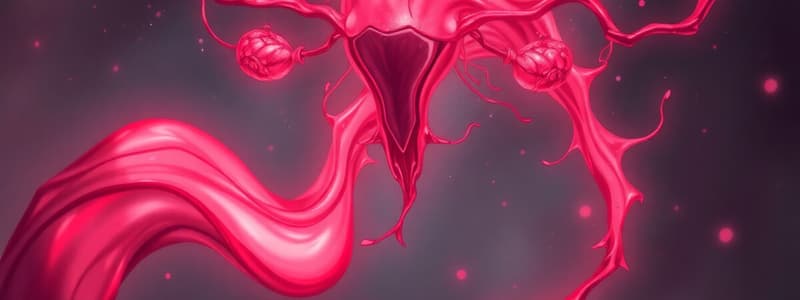Podcast
Questions and Answers
Which of the following physiological changes is LEAST likely to be associated with primary dysmenorrhea?
Which of the following physiological changes is LEAST likely to be associated with primary dysmenorrhea?
- Decreased prostaglandin levels (correct)
- Increased myometrial contractions
- Increased cyclooxygenase (COX) enzyme activity
- Heightened pain sensitivity
A 15-year-old patient has not experienced menarche. Which condition is LEAST likely to be a cause of her primary amenorrhea?
A 15-year-old patient has not experienced menarche. Which condition is LEAST likely to be a cause of her primary amenorrhea?
- Turner syndrome
- Polycystic ovary syndrome (PCOS)
- Endometriosis (correct)
- Hypothalamic amenorrhea
A woman experiences cessation of menses for 7 months. She is not pregnant or lactating. Which hormonal imbalance is LEAST likely to be the sole cause of her secondary amenorrhea?
A woman experiences cessation of menses for 7 months. She is not pregnant or lactating. Which hormonal imbalance is LEAST likely to be the sole cause of her secondary amenorrhea?
- Hyperprolactinemia
- Decreased LH (correct)
- Elevated FSH
- Hypothyroidism
Which endometrial characteristic is LEAST likely to be associated with anovulatory AUB?
Which endometrial characteristic is LEAST likely to be associated with anovulatory AUB?
Which hormone level is LEAST likely to be elevated in women with PCOS?
Which hormone level is LEAST likely to be elevated in women with PCOS?
Which statement regarding hydrocele pathophysiology is most accurate?
Which statement regarding hydrocele pathophysiology is most accurate?
A patient presents with a painless, small, movable lump in the scrotum, superior and posterior to the testicle. Which of the following findings would LEAST support a diagnosis of spermatocele?
A patient presents with a painless, small, movable lump in the scrotum, superior and posterior to the testicle. Which of the following findings would LEAST support a diagnosis of spermatocele?
Which of the following is least likely to be associated with acute bacterial prostatitis (ABP)?
Which of the following is least likely to be associated with acute bacterial prostatitis (ABP)?
Which of the following factors is LEAST likely to be directly involved in the pathophysiology of benign prostatic hyperplasia (BPH)?
Which of the following factors is LEAST likely to be directly involved in the pathophysiology of benign prostatic hyperplasia (BPH)?
What cellular process is LEAST directly associated with the development of leiomyomas?
What cellular process is LEAST directly associated with the development of leiomyomas?
Which statement regarding the pathophysiology of endometriosis is least accurate?
Which statement regarding the pathophysiology of endometriosis is least accurate?
Which factor is LEAST likely to be associated with an increased risk of endometrial polyps?
Which factor is LEAST likely to be associated with an increased risk of endometrial polyps?
Which of the following is LEAST likely to be a risk factor for cervical cancer?
Which of the following is LEAST likely to be a risk factor for cervical cancer?
Which condition is LEAST associated with prolonged exposure to unopposed estrogen, a primary risk factor for endometrial cancer?
Which condition is LEAST associated with prolonged exposure to unopposed estrogen, a primary risk factor for endometrial cancer?
Which factor is LEAST likely to be associated with an increased risk of ovarian cancer?
Which factor is LEAST likely to be associated with an increased risk of ovarian cancer?
Which of the following is the LEAST likely symptom of acute HIV infection?
Which of the following is the LEAST likely symptom of acute HIV infection?
Which statement about Chlamydia trachomatis is LEAST accurate?
Which statement about Chlamydia trachomatis is LEAST accurate?
Which manifestation is LEAST likely to be associated with tertiary syphilis?
Which manifestation is LEAST likely to be associated with tertiary syphilis?
Which of the following characteristics of breast lesions is LEAST associated with an increased risk of breast cancer?
Which of the following characteristics of breast lesions is LEAST associated with an increased risk of breast cancer?
What is the LEAST likely presenting sign of breast cancer?
What is the LEAST likely presenting sign of breast cancer?
Which of the following factors is most directly responsible for the myometrial contractions observed in primary dysmenorrhea?
Which of the following factors is most directly responsible for the myometrial contractions observed in primary dysmenorrhea?
A 13-year-old girl has not experienced menarche and shows no secondary sexual characteristics. Further investigation reveals elevated FSH levels. Which of the following is the most likely underlying cause?
A 13-year-old girl has not experienced menarche and shows no secondary sexual characteristics. Further investigation reveals elevated FSH levels. Which of the following is the most likely underlying cause?
A 28-year-old woman experiences secondary amenorrhea. Her prolactin levels are significantly elevated, but she is not pregnant or lactating. Which mechanism is most likely contributing to her amenorrhea?
A 28-year-old woman experiences secondary amenorrhea. Her prolactin levels are significantly elevated, but she is not pregnant or lactating. Which mechanism is most likely contributing to her amenorrhea?
During an anovulatory cycle, the endometrium becomes unstable, thicker, and more vascularized. What hormonal imbalance is most directly responsible for these endometrial changes?
During an anovulatory cycle, the endometrium becomes unstable, thicker, and more vascularized. What hormonal imbalance is most directly responsible for these endometrial changes?
A woman with PCOS presents with elevated LH levels and normal FSH levels. Which of the following is the most direct consequence of persistent LH elevation in PCOS?
A woman with PCOS presents with elevated LH levels and normal FSH levels. Which of the following is the most direct consequence of persistent LH elevation in PCOS?
A 45-year-old man is diagnosed with a varicocele. Which pathophysiological mechanism is most likely the primary cause of varicocele development?
A 45-year-old man is diagnosed with a varicocele. Which pathophysiological mechanism is most likely the primary cause of varicocele development?
A patient presents with sudden, severe testicular pain, nausea, vomiting, and abdominal pain. Examination reveals an elevated and tender testicle. Which of the following pathophysiological processes is most likely responsible for these symptoms?
A patient presents with sudden, severe testicular pain, nausea, vomiting, and abdominal pain. Examination reveals an elevated and tender testicle. Which of the following pathophysiological processes is most likely responsible for these symptoms?
Which of the following pathophysiological processes is most directly responsible for the symptoms observed in acute bacterial prostatitis (ABP)?
Which of the following pathophysiological processes is most directly responsible for the symptoms observed in acute bacterial prostatitis (ABP)?
Which of the following hormonal factors is most likely implicated in the pathophysiology of benign prostatic hyperplasia (BPH)?
Which of the following hormonal factors is most likely implicated in the pathophysiology of benign prostatic hyperplasia (BPH)?
Which cellular component is the primary origin of leiomyomas?
Which cellular component is the primary origin of leiomyomas?
Which pathophysiologic process is most directly responsible for the pain associated with endometriosis?
Which pathophysiologic process is most directly responsible for the pain associated with endometriosis?
Which of the following factors is most directly linked to the development of endometrial polyps?
Which of the following factors is most directly linked to the development of endometrial polyps?
Which of the following biological processes is most directly disrupted by HPV E6 and E7 oncoproteins in the development of cervical cancer?
Which of the following biological processes is most directly disrupted by HPV E6 and E7 oncoproteins in the development of cervical cancer?
A woman with a history of prolonged estrogen-only hormone replacement therapy is at increased risk for endometrial cancer. What is the most direct pathophysiological effect of prolonged unopposed estrogen exposure on the endometrium?
A woman with a history of prolonged estrogen-only hormone replacement therapy is at increased risk for endometrial cancer. What is the most direct pathophysiological effect of prolonged unopposed estrogen exposure on the endometrium?
Which of the following genetic factors is most strongly associated with an increased risk of ovarian cancer?
Which of the following genetic factors is most strongly associated with an increased risk of ovarian cancer?
What is the primary mechanism by which HIV establishes chronic infection after initial exposure?
What is the primary mechanism by which HIV establishes chronic infection after initial exposure?
Which cellular process most accurately describes how Chlamydia trachomatis establishes infection?
Which cellular process most accurately describes how Chlamydia trachomatis establishes infection?
Which immunopathological mechanism is primarily responsible for the destructive lesions observed in tertiary syphilis?
Which immunopathological mechanism is primarily responsible for the destructive lesions observed in tertiary syphilis?
A woman is diagnosed with atypical ductal hyperplasia (ADH). Which of the following statements best describes the significance of this diagnosis regarding breast cancer risk?
A woman is diagnosed with atypical ductal hyperplasia (ADH). Which of the following statements best describes the significance of this diagnosis regarding breast cancer risk?
Which genetic alteration is most directly involved in the pathophysiology of breast cancer development?
Which genetic alteration is most directly involved in the pathophysiology of breast cancer development?
Flashcards
Primary Dysmenorrhea
Primary Dysmenorrhea
Painful menstruation typically involving recurrent pain 48-72 hours before/during menstruation, with possible symptoms like backache, anorexia, nausea, vomiting, diarrhea and headache.
Primary Amenorrhea
Primary Amenorrhea
The absence of a first menstrual period by age 14 with no development of secondary sex characteristics or by age 16 regardless of secondary sex characteristics.
Secondary Amenorrhea
Secondary Amenorrhea
Defined as the cessation of menses for more than 6 months.
Polycystic Ovary Syndrome (PCOS)
Polycystic Ovary Syndrome (PCOS)
Signup and view all the flashcards
Hydrocele
Hydrocele
Signup and view all the flashcards
Varicocele
Varicocele
Signup and view all the flashcards
Spermatocele
Spermatocele
Signup and view all the flashcards
Testicular Torsion
Testicular Torsion
Signup and view all the flashcards
Cryptorchidism
Cryptorchidism
Signup and view all the flashcards
Prostatitis
Prostatitis
Signup and view all the flashcards
Benign Prostatic Hyperplasia (BPH)
Benign Prostatic Hyperplasia (BPH)
Signup and view all the flashcards
Leiomyomas
Leiomyomas
Signup and view all the flashcards
Endometriosis
Endometriosis
Signup and view all the flashcards
Endometrial Polyps
Endometrial Polyps
Signup and view all the flashcards
Cervical Cancer
Cervical Cancer
Signup and view all the flashcards
Endometrial Cancer
Endometrial Cancer
Signup and view all the flashcards
Ovarian Cancer
Ovarian Cancer
Signup and view all the flashcards
HIV/AIDS
HIV/AIDS
Signup and view all the flashcards
Herpes Simplex Virus Infection (HSV)
Herpes Simplex Virus Infection (HSV)
Signup and view all the flashcards
Chlamydia
Chlamydia
Signup and view all the flashcards
Dysmenorrhea Pathophysiology
Dysmenorrhea Pathophysiology
Signup and view all the flashcards
Abnormal Uterine Bleeding (AUB)
Abnormal Uterine Bleeding (AUB)
Signup and view all the flashcards
Hydrocele Pathophysiology
Hydrocele Pathophysiology
Signup and view all the flashcards
Acute Bacterial Prostatitis (ABP) Symptoms
Acute Bacterial Prostatitis (ABP) Symptoms
Signup and view all the flashcards
Leiomyomas Pathophysiology
Leiomyomas Pathophysiology
Signup and view all the flashcards
Syphilis Pathophysiology
Syphilis Pathophysiology
Signup and view all the flashcards
Breast Cancer Progression
Breast Cancer Progression
Signup and view all the flashcards
Study Notes
Common Risk Factors for Breast Cancer
- Age risk increases with age, with higher risk for 65+ than <65
Pathophysiology of Sexually Transmitted Infections
- In congenital syphilis, T. pallidum is transmitted to the fetus during pregnancy
Gonorrhea
- Gonococci can infect the endocervical canal in women and the urethra in men.
- Several factors facilitates bacteria into into the fallopian tubes and causes(PID) pelvic inflammatory disease.
- The fallopian tubes causes mucosal and submucosal invasion, of ciliated epithelium, and inflammation with Bacteria adhere to sperm and are transported to the fallopian tubes.
- Epididymitis, prostatitis, bartholinitis and endometritis are complicated infections for men and women potentially to PID
Studying That Suits You
Use AI to generate personalized quizzes and flashcards to suit your learning preferences.



